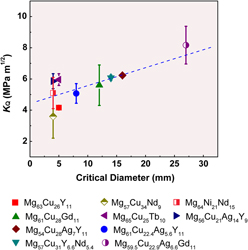Crossref Citations
This article has been cited by the following publications. This list is generated based on data provided by
Crossref.
Zhao, Yuan-Yun
and
Zhao, Xu
2012.
Structural relaxation and its influence on the elastic properties and notch toughness of Mg–Zn–Ca bulk metallic glass.
Journal of Alloys and Compounds,
Vol. 515,
Issue. ,
p.
154.
Zhang, Leilei
Li, Ran
Wang, Jianfeng
Zhang, Huiyan
Hua, Nengbin
and
Zhang, Tao
2012.
The influence of Ag substitution for Cu on glass-forming ability and thermal properties of Mg-based bulk metallic glasses.
Journal of Non-Crystalline Solids,
Vol. 358,
Issue. 12-13,
p.
1425.
Wang, Shao-Gang
Sun, Ming-Yue
Song, Zhen-Qiang
and
Xu, Jian
2012.
Cast defects induced sample-size dependency on compressive strength and fracture toughness of Mg–Cu–Ag–Gd bulk metallic glass.
Intermetallics,
Vol. 29,
Issue. ,
p.
123.
Wang, Shao-Gang
and
Xu, Jian
2013.
Strengthening and toughening of Mg-based bulk metallic glass via in-situ formed B2-type AgMg phase.
Journal of Non-Crystalline Solids,
Vol. 379,
Issue. ,
p.
40.
Liu, Z. Q.
and
Zhang, Z. F.
2013.
Universal softening and intrinsic local fluctuations in metallic glasses.
Applied Physics Letters,
Vol. 103,
Issue. 18,
p.
181909.
Liu, Z. Q.
and
Zhang, Z. F.
2014.
Strengthening and toughening metallic glasses: The elastic perspectives and opportunities.
Journal of Applied Physics,
Vol. 115,
Issue. 16,
Pan, Haijun
Meng, Xiangying
An, Qi
Wen, Xiaohong
Qin, Gaowu
and
Goddard, William A.
2014.
The relation of mechanical properties and local structures in bulk Mg 54 (Cu 1− x Ag x ) 35 Y 11 metallic glasses: Ab initio molecular dynamics simulations.
Computational Materials Science,
Vol. 92,
Issue. ,
p.
313.
Song, Zhen-Qiang
Ma, Evan
and
Xu, Jian
2016.
Mode III fracture toughness of the Zr61Ti2Cu25Al12 bulk metallic glass.
Acta Materialia,
Vol. 109,
Issue. ,
p.
275.
Rozenberg, Silvia
Audebert, Fernando
Galano, Marina
Ogando, Isabel Vergara
and
Mendive, Cecilia
2016.
Effect of Al addition to Rapidly Solidified Mg-Cu-Rare Earth Alloys.
Materials Research,
Vol. 19,
Issue. suppl 1,
p.
2.
Wang, Xin
Zhao, Lichen
Hu, Ximei
Cheng, Yongjian
Liu, Shuiqing
Chen, Peng
and
Cui, Chunxiang
2017.
Fabrication and Mechanical Behavior of Ex Situ Mg-Based Bulk Metallic Glass Matrix Composite Reinforced with Electroless Cu-Coated SiC Particles.
Materials,
Vol. 10,
Issue. 12,
p.
1371.
Erkartal, Mustafa
and
Durandurdu, Murat
2018.
An in-depth investigation of Mg-Zn-Ca metallic glasses: A first principles study.
Computational Materials Science,
Vol. 153,
Issue. ,
p.
326.
Zhou, Jing
Wang, Qianqian
Hui, Xidong
Zeng, Qiaoshi
Xiong, Yuwei
Yin, Kuibo
Sun, Baoan
Sun, Litao
Stoica, Mihai
Wang, Weihua
and
Shen, Baolong
2020.
A novel FeNi-based bulk metallic glass with high notch toughness over 70 MPa m1/2 combined with excellent soft magnetic properties.
Materials & Design,
Vol. 191,
Issue. ,
p.
108597.
Biały, Michał
Hasiak, Mariusz
and
Łaszcz, Amadeusz
2022.
Review on Biocompatibility and Prospect Biomedical Applications of Novel Functional Metallic Glasses.
Journal of Functional Biomaterials,
Vol. 13,
Issue. 4,
p.
245.
Zhang, Jingyao
Li, Jing
Jing, Mei
Zhao, Lichen
Qi, Yumin
Yang, Wei
and
Wang, Xin
2023.
The Effect of Electroplating Nickel on the Mechanical Properties of Brittle Mg-Based Bulk Metallic Glasses.
Coatings,
Vol. 13,
Issue. 9,
p.
1598.
Liu, Ming
2023.
Characterization of bulk metallic glasses by microscratch test under Rockwell C diamond indenter and progressive normal load.
Engineering Fracture Mechanics,
Vol. 281,
Issue. ,
p.
109126.
Xu, Zhitong
Liu, Ming
and
Yang, Fuqian
2024.
Calculation of elastic constants of bulk metallic glasses from indentation tests.
Journal of Materials Research and Technology,
Vol. 28,
Issue. ,
p.
4382.





